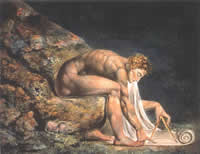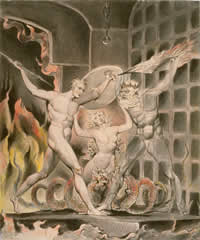
The Ancient of Days
(God as an Architect) 1794

Newton (1795), colour print with
pen & ink and watercolour

The Great Red Dragon and the Woman Clothed with the Sun
Pen and watercolour,
435 x 345 mm

Pity, colour print on paper
finished in ink
and watercolour c. 1795

The Temptation and Fall of Eve
Dimensions: 49.7 x 38.7 cm

Whirlwind of lovers
(Illustration to Dante's Inferno)

Satan, Sin, and Death: Satan Comes to the Gates of Hell: an illustration by William Blake to Milton’s Paradise Lost c. 1806
|
Historical Artist - William Blake (1757 - 1827)
William Blake lived in London and was trained as an engraver. He attended the Royal Academy Schools for a short period before dropping out to pursue more creative endeavors. William Blake created “illuminated printing” which he used to illustrate his poetry. His subject matter often reflected the themes in his writing, normally his own eccentric and intricate mythology.
William Blake was largely unrecognised during his lifetime but today his work is considered seminal and significant in the history of both poetry and the visual arts. Blake is highly regarded today for his expressiveness and creativity, and the philosophical vision that underlies his work.
William Blake's affection for the Bible was accompanied by hostility for the established Church, his beliefs modified by a fascination with Mysticism and the unfolding of the Romantic Movement around him.
William Blake was born in London, England on 28 November 1757, to a middle-class family. He was the third of seven children, who consisted of one girl and six boys, two of whom died in infancy. William Blake's father, James, was a hosier. He never attended school, being educated at home by his mother.The Bible was an early and profound influence on Blake, and would remain a source of inspiration throughout his life.
William Blake began engraving copies of drawings of Greek antiquities purchased for him by his father (a further indication of the support his parents lent their son), a practice that was then preferred to actual drawing. Within these drawings Blake found his first exposure to classical forms, through the work of Raphael, Michelangelo, Marten Heemskerk and Albrecht Dürer. His parents knew enough of his headstrong temperament that he was not sent to school but was instead enrolled in drawing classes. He read avidly on subjects of his own choosing. During this period, Blake was also making explorations into poetry; his early work displays knowledge of Ben Jonson and Edmund Spenser.
In 1772, William Blake became apprenticed to engraver James Basire of Great Queen Street, for the term of seven years. At the end of this period, at the age of 21, he was to become a professional engraver. After two years Basire sent William Blake to copy images from the Gothic churches in London, and his experiences in Westminster Abbey contributed to the formation of his artistic style and ideas; the Abbey of his day was decorated with suits of armour, painted funeral effigies and varicoloured waxworks.
In 1778, William Blake became a student at the Royal Academy in Old Somerset House. While the terms of his study required no payment, he was expected to supply his own materials throughout the six-year period. There, he rebelled against what he regarded as the unfinished style of fashionable painters such as Rubens, championed by the school's first president, Joshua Reynolds. Over time, William Blake came to detest Reynolds' attitude toward art, especially his pursuit of "general truth" and "general beauty". Reynolds wrote in his Discourses that the "disposition to abstractions, to generalizing and classification, is the great glory of the human mind"; William Blake responded, in marginalia to his personal copy, that "To Generalize is to be an Idiot; To Particularize is the Alone Distinction of Merit". William Blake also disliked Reynolds' apparent humility, which he held to be a form of hypocrisy. Against Reynolds' fashionable oil painting, William Blake preferred the Classical precision of his early influences, Michelangelo and Raphael.
In 1782, William Blake met John Flaxman, who was to become his patron, and Catherine Boucher, who was to become his wife. Later, in addition to teaching Catherine to read and write, William Blake trained her as an engraver; throughout his life she would prove an invaluable aid to him, helping to print his illuminated works and maintaining his spirits throughout numerous misfortunes.
A After his father's death, William Blake and his brother Robert opened a print shop in 1784. William Blake illustrated Original Stories from Real Life (1788; 1791) by Mary Wollstonecraft.
In 1788, at the age of 31, William Blake began to experiment with relief etching, a method he would use to produce most of his books, paintings, pamphlets and of course his poems, including his longer 'prophecies' and his masterpiece the "Bible". The process is also referred to as illuminated printing, and final products as illuminated books or prints. William Blake used illuminated printing for most of his well-known works, including Songs of Innocence and Experience, The Book of Thel, The Marriage of Heaven and Hell, and Jerusalem.
Around the year 1800 William Blake moved to a cottage at Felpham in Sussex to take up a job illustrating the works of William Hayley, a minor poet. Over time, William Blake came to resent his new patron, coming to believe that Hayley was not paying as well as he could afford to pay. William Blake returned to London in 1802 and began to write and illustrate Jerusalem (1804–1820), his most ambitious work. Having conceived the idea of portraying the characters in Chaucer's Canterbury Pilgrims, William Blake approached the dealer Robert Cromek, with a view to marketing an engraving. Knowing that Blake was too eccentric to produce a popular work, Cromek promptly commissioned Thomas Stothard to execute the concept. When William Blake learned that he had been cheated, he broke off contact with Stothard, formerly a friend. He also set up an independent exhibition in his brother's shop, designed to market his own version of the Chaucer illustraton, along with other works.
William Blake was introduced by George Cumberland to a young artist named John Linnell. Through Linnell he met Samuel Palmer, who belonged to a group of artists who called themselves the Shoreham Ancients. This group shared Blake's rejection of modern trends and his belief in a spiritual and artistic New Age. At the age of 65 Blake began work on illustrations for the Book of Job. These works were later admired by Ruskin, who compared Blake favourably to Rembrandt, and by Vaughan Williams, who based his Job: A Masque for Dancing on a selection of the illustrations.
William Blake abhorred slavery and believed in racial and sexual equality. He rejected all forms of imposed authority; indeed, he was charged with assault and uttering seditious and treasonable expressions against the King in 1803, though he later was cleared of the charges. William Blake's views on what he saw as oppression and restriction of rightful freedom extended to the Church. His spiritual beliefs are evidenced in Songs of Experience (in 1794), in which he shows his own distinction between the Old Testament God, whose restrictions he rejected, and the New Testament God whom he saw as a positive influence.
Later in his life William Blake began to sell a great number of his works, particularly his Bible illustrations, to Thomas Butts, a patron who saw William Blake more as a friend than a man whose work held artistic merit; this was typical of the opinions held of William Blake throughout his life.
On the day of his death, William Blake worked relentlessly on his Dante series. Eventually, it is reported, he ceased working and turned to his wife, who was in tears by his bedside. Beholding her, William Blake is said to have cried, "Stay Kate! Keep just as you are – I will draw your portrait – for you have ever been an angel to me." Having completed this portrait (now lost), William Blake laid down his tools and began to sing hymns and verses. At six that evening, after promising his wife that he would be with her always, William Blake died.
Quotes an art by William Blake
" Invention depends altogether, upon execution or organization; as that is right or wrong so is the invention perfect or imperfect. Whoever is set to undermine the execution of art is set to destroy art. Michael Angelo's art depends on Michael Angelo's execution altogether."
" Knowledge of the ideal beauty is not be acquired. It is born with us. Innate ideas are in every man, born with him; they are truly himself. The man who says that we have no innate ideas must be a fool & knave, having no con-science or innate science."
" The difference between a bad artist and a good one is: The bad artist seems to copy a great deal. The good one really does copy a great deal."
" To generalize is to be an idiot. To particularize is alone distinction of merit."
" Colouring does not depend on where the colours are put, but on where the lights and darks are put, and all depends on form or outline. On where that is put; where that is wrong, the colour can never be right; and it is always wrong in Titian and Correggio, Rubens and Rembrandt."
Contemporary United Kingdom Artists
Art Galleries in the United Kingdom |
